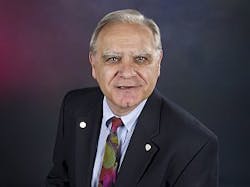LANL physicist George Kyrala honored with research award
Los Alamos, NM--Los Alamos National Laboratory (LANL) physicist George Kyrala is part of a team honored with the American Physical Society’s 2012 John Dawson Award for Excellence in Plasma Physics Research. The team, which also includes researchers from Lawrence Livermore National Laboratory (LLNL), is being recognized for its work on a far-reaching discovery about laser-matter interaction, which has important implications for LLNL’s National Ignition Facility (NIF).
The award is for “predicting and demonstrating the technique of laser scatter on self-generated plasma-optics gratings that enables generation and redirection of high-energy laser beams important for indirect drive inertial confinement fusion and high-power laser-matter interactions.”
The research has roots in discoveries from the late 1990s, when physicists noted that laser beams crossing each other’s paths in plasma could exchange energy. This could potentially degrade the implosion symmetry of targets, a crucial requirement for fusion ignition. This is one of many phenomena known as laser-plasma interaction, in which the plasma created by a laser can interfere with the beam.
Over the next 15 years, researchers conducted experiments at the University of Rochester's OMEGA laser and developed new physics models run on supercomputers to better understand the phenomenon. This led to the conclusion that the energy transfer process could be controlled using slight adjustments to the laser beams’ wavelengths, and even be used as a novel tool to tune the implosion symmetry of NIF targets.
In addition to Kyrala, the team is comprised of Debra Ann Callahan, Edward Williams, Nathan Meezan, Laurent Divol, Robert Kirkwood, and Pierre Michel. They will accept the Dawson Award at the annual meeting of the American Physical Society Division of Plasma Physics (Providence, RI). The team will receive a $5,000 cash award (to be divided equally) and a certificate.
Kyrala received his bachelor’s degree from the American University in Beirut, and a doctorate in atomic physics from Yale University, where he was a Gibbs Fellow. He joined the High Energy Density group of the Physics Division at Los Alamos in 1979. An expert on ultra high-speed diagnostics of lasers, X-rays, and the plasmas generated, Kyrala is a Fellow of the American Physical Society and the International Society for Optical Engineers. He has chaired conferences on high-speed imaging and on X-ray generation and applications. Kyrala has received many international awards, including the Photosonics Award and the Harold E. Edgerton Award.
-----
Subscribe now to Laser Focus World magazine; it's free!
